Quazi
Member
So, I found myself stuck in a position where I was going to be repeating the same information as yet another person decided to try and repeat the same "lumens are useless for plants" sentence they undoubtedly picked up in a forum or on a website.
Fine, I'll repeat myself, again. But, I decided that a thread would be more suitable so I wouldn't have to keep repeating myself. Unfortunately, this is going to be long and a bit technical because it's much harder to teach an old dog new tricks.
Hold on...

...now then:
To say lumens are a useless level of measure is to say that inches are a useless level of measure since they aren't the centimeter.
The rest of the world thinks that inches are a useless measurement; doesn't that make them invalid? No. It's just that they have to be used correctly in conversation. In order to do that, you need to really understand what you're talking about.


 The Truth About PAR, Lumens, and Plants (May Surprise You)
The Truth About PAR, Lumens, and Plants (May Surprise You)


First, let's set one thing straight about lumens: they are not useless when discussing plants. As such, that is the point of this post. By the end, hopefully you will understand that lumens do matter. While they aren't the ideal unit of measurement when talking about light and plants: that doesn't make them useless.
Lumens are a measure of lux which we (humans) use to determine the relative brightness from a light source. Yes it's based on the sensitivity of the eye. That's because it's the only tool our bodies have to safely and easily detect light. Of course we would have a measurement based on this. We could use our other method of detecting light: our skin. But that wouldn't work very well, especially for plants because our skin is affected by light differently than our eyes. We're talking about lumens, not sunburns.
However, to say lumens are useless, is to completely discount the fact that humans have vision in overlapping areas within the PAR of the spectrum in similar strengths of response. If that didn't make sense, read on. If you think that made sense, please read on.
Allow me to illustrate.
Lumens are measured based on the way humans perceive different wavelengths of light. According to the most recent (and they are fairly recent in scientific standards) measurement, the response that humans have to various wavelengths is illustrated here:
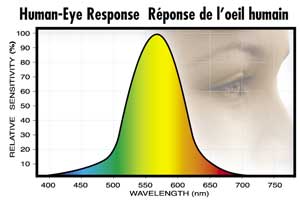
(Don't pay attention to the colors in the image as they are highly inaccurate; more about the source of information when you're discussing light and PAR in a bit...)
Let's talk about luminous intensity for a second.
Do a search for "PAR plants" in Google and you'll find a couple of things: people talking about "PAR watts" in forums, and specialty lighting/aquarium stores explaining them to you.
The most commonly quoted (unfortunately) information about lumens and plants is on a website that sells specialty lights for plant growth (go figure):
Lumens are a standard measurement of something called "luminous flux." Luminous flux, is exactly like radiant flux except it is adjusted for the sensitivity that you see in the image above.
In case you aren't catching on already: luminous flux does derive from the measurement for electromagnetic radiation where your beloved photons come from.
The image above, is actually displaying how the human eye responds in accordance to a mathematical formula called the photopic luminosity function, with some nifty colors added (albeit terribly). The photopic luminosity function looks like this:

I know, it's a bunch of symbols and garbage to most. Well, the important part in the equation is around the J as it indicates the measurement for the power per wavelength (or power spectral density (PSD) if you wanna get technical). Power, if you recall from your physics class, is the amount of energy transferred over time.
In this case, electromagnetic radiation: photons.
Notice that the rest of the explanation on the aforementioned page continues to provide useless information to continue to fill your head with stuff to distract you from regular light bulbs? Just silly.
Now that we're all on the same page, we can see that the measure of lumens is related to photons and light energy; it's just not tailored for plants and how they perceive/react to the light.
I don't even need to mention "PAR watts" because, frankly, it isn't necessary to prove my point now that you see that lumens do relate to energy from light sources.
Now we can look at more pretty pictures.
The next thing I want to make sure everyone is on the same page about is PAR.
First of all, this:

...is not PAR.

In fact, before I go into PAR, I would like to take this moment to point out that that not all graphs are created equal. As such, the aforementioned source of information concerning PAR has horribly inaccurate graphs when it comes to color. From looking at their graphs, one would assume the color green in the wavelength is around 515nm or so. This is not true. The green shade starts around 500nm with it ending at 579nm. By the time you've hit 580nm on their chart, you're already deep in the orange already and heading to red which shouldn't happen until around 630nm on an accurate chart of the visible spectrum. Plopping a rainbow on a graph does not make it accurate, thanks.

PAR stands for photosynthetically active radiation. In other words: the area of the spectrum of light (or color) where plants and light interact. I say interact, because there are two things to look at when you're talking about light and plants, how well chlorophyll a, chlorophyll b, and the carotenoids absorb the light that is coming in and the rate at which photosynthesis occurs relating to different spectrums or the "action spectrum."
Chlorophyll a absorbs red and dark-bluish light.
Chlorophyll b absorbs orangish and light-bluish light.
The carotenoids absorb the blues and purple which is towards the ultraviolet end of the spectrum where radiation can be harmful to cellular life at certain levels. As such, the carotenoids also help to protect the plant from this radiation.
Most other colors are reflected giving off the green tone that you are so familiar with.
Here's a chart so you can see the difference between the two and the specifics for all the information regarding photosynthesis and the visible light spectrum:
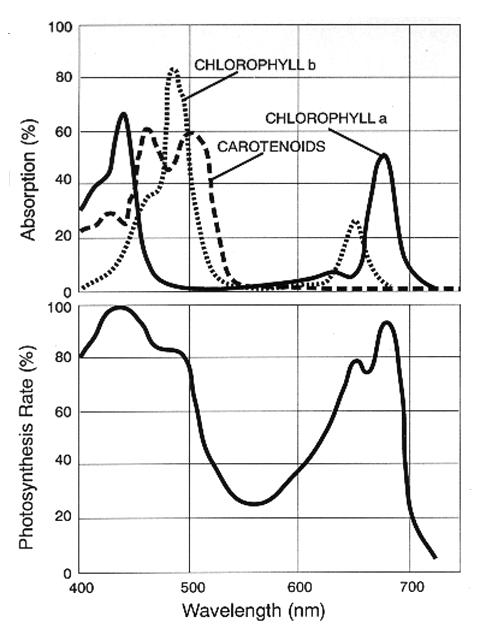
Now then, the chart I showed you, before the academic one above, is attempting to illustrate the the "photosynthetic response curve." It's sort of an average of the two charts above, taking into account the absorption and the rate of photosynthesis. Unfortunately, because it was made by a plant-lighting company, it fails to drop the curve down appropriately in the 550-625 wavelength range. Not only that, but it also displays the wavelength colors in contrary to a little thing we call reality.
So, I decided to grab an accurate representation of the visible area of the spectrum from an encyclopedic source. I then scaled it appropriately to match the correct wavelengths given on these graphs from an academic source. After this, I laid them over the charts in the graph:
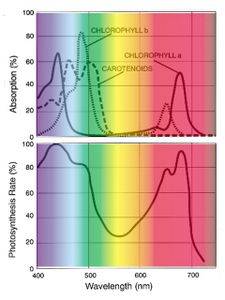
Now we can get a better idea. But we still don't have that nice view of the "photosynthetic response curve." Why do we need it? Let's use averages no more and just look at the data as it exists. So, this is a much more accurate representation of PAR as it doesn't require a "curve" to be applied to account for the two sets of information. Hope you like it:
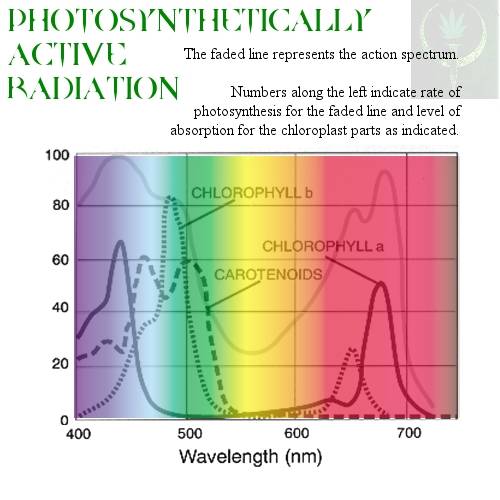
So please, when you're talking about PAR, stop showing pictures created by a lighting company that show an averaged "photosynthetic response curve." Either show the photosynthetic response curve, or talk about photosynthetically active radiation. Just don't get them confused. Now you have an image I painstakingly crafted to help you along the way too.
NOW that we are on the same page about lumens being related to the energy produced in light, photosynthetically active radiation, and the photosynthetic response curve... I can start to prove my point.
Companies will show you the relative response curve that lumens are measured from and tell you that it's only useful to human vision and, therefore, has no other application especially when talking about plants. They will usually follow up the explanation with further explanation of "PAR watts" and how they are so much better. After that, you'll get to read about how specialty grow lights are so much better because they have a higher PAR watts rating, or you can just browse the rest of their site and get the same effect. This is a tool that they use to help sell you their products. They are not providing the information to be helpful. If they were: they would be a teacher and they might be writing a book about it.
All the chart proves about humans is that they are more sensitive to yellows and greens in the spectrum. Does this mean we can't see purple or dark red? No. It just means that our eyes do not react to those wavelengths of light as strongly as they do for those wavelengths existing in yellow or green. This is why caution signs are painted in special paint that reflects yellow light with negative space in them at drivers on the road.
By the way, don't get confused when talking about color. Colors, as we see them, are due to all other wavelengths being absorbed by a surface or pigment and thus, a resulting wavelength is reflected.
Because humans can see or, visibly perceive, the relative brightness of a light, they can determine the strength of that light wavelength regardless of how well their eyes react to it as long as there is some existence of visible light.
Case in point: black lights. They emit a deep purple light on the end of the spectrum where our eyes are barely sensitive. If you show me a 100W black light and a 300W black light, I can tell you which one is emitting more light and power by looking at them. I can't tell you this because I have super-human strength. I can tell you this, because I can observe the lumens coming from the lamp.
By the argument of those preaching "PAR watts," my statement about which black light is brighter is voided out by the fact that lumens are not finely attuned to that particular area of the spectrum. While that may be true, it still doesn't discount the fact that using lumens to determine how much ultraviolet light is coming from one source compared to another was a perfectly suitable method for describing and factually stating the relative perceived ultraviolet light.
See? Lumens are useful even for describing light and it's power even in cases where we have little-to-minute sensitivity to particular wavelengths.
Now, that was an extreme example using a spectrum that human eyes are not very sensitive to. However, it was done to further emphasize my final point.
If we look at how lumens are measured, and we overlap it upon our previous image (which I won't do, because you can visualize a bell in the middle of the image easily enough), you can see that there are plenty of areas which not only overlap, but do so in strong correlation in many areas especially when compared to the overlapping area between human response. In some areas, there is such strong correlation that humans are actually more suited in observing useful light for plants than plants are!
To go back to our example: if you can explain how changes in ultraviolet light and energy correlate to changes in perceived lumens, then you can certainly use lumens to explain/compare other areas of photosynthetically active radiation that are far more sensitive according to the photopic luminosity function.
So... no. Lumens are not useless when discussing plants and how much energy they can potentially receive from given light sources. Can we stop saying they are, now?
There you have it. Please let me know if there are any corrections because I'm certainly open to them.
Just make sure you're not giving me information from a company that makes a living off of you thinking regular lights and their measurements are "useless."
'cause if you do, I'm gonna use their information against them and do something like proving my point without using a single word:
Are lumens "useless" for plants? Let's ask Company A:


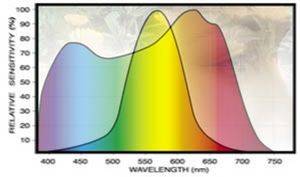
Oops looks like lumens are related. Someone better find a bigger bag because this cat is running around everywhere.
Again, please don't mistaken this post for me saying lumens are the most appropriate unit of measurement when talking about light and plants. That is not what I am trying to say. What I am trying to instill in the reader is that lumens are not useless when we're talking about lights and plants.
-Q
Fine, I'll repeat myself, again. But, I decided that a thread would be more suitable so I wouldn't have to keep repeating myself. Unfortunately, this is going to be long and a bit technical because it's much harder to teach an old dog new tricks.
Hold on...

...now then:
To say lumens are a useless level of measure is to say that inches are a useless level of measure since they aren't the centimeter.
The rest of the world thinks that inches are a useless measurement; doesn't that make them invalid? No. It's just that they have to be used correctly in conversation. In order to do that, you need to really understand what you're talking about.


 The Truth About PAR, Lumens, and Plants (May Surprise You)
The Truth About PAR, Lumens, and Plants (May Surprise You)


First, let's set one thing straight about lumens: they are not useless when discussing plants. As such, that is the point of this post. By the end, hopefully you will understand that lumens do matter. While they aren't the ideal unit of measurement when talking about light and plants: that doesn't make them useless.
Lumens are a measure of lux which we (humans) use to determine the relative brightness from a light source. Yes it's based on the sensitivity of the eye. That's because it's the only tool our bodies have to safely and easily detect light. Of course we would have a measurement based on this. We could use our other method of detecting light: our skin. But that wouldn't work very well, especially for plants because our skin is affected by light differently than our eyes. We're talking about lumens, not sunburns.
However, to say lumens are useless, is to completely discount the fact that humans have vision in overlapping areas within the PAR of the spectrum in similar strengths of response. If that didn't make sense, read on. If you think that made sense, please read on.
Allow me to illustrate.
Lumens are measured based on the way humans perceive different wavelengths of light. According to the most recent (and they are fairly recent in scientific standards) measurement, the response that humans have to various wavelengths is illustrated here:

(Don't pay attention to the colors in the image as they are highly inaccurate; more about the source of information when you're discussing light and PAR in a bit...)
Let's talk about luminous intensity for a second.
Do a search for "PAR plants" in Google and you'll find a couple of things: people talking about "PAR watts" in forums, and specialty lighting/aquarium stores explaining them to you.
The most commonly quoted (unfortunately) information about lumens and plants is on a website that sells specialty lights for plant growth (go figure):
Well damn! From that, I must be out of my gord to continue this thread! Search around a bit more and you'll find many other lighting or horticulture companies offering a similar explanation. Don't believe everything you read on the internet. While that's a decent explanation, it is obviously biased and therefore: flawed. Stay with me here 'cause it's probably gonna get a little thick.Measuring Light for Humans: Lumens and Lux
First, how do we measure light quantity for humans? The obvious way is based on how bright the source appears and how "well" the eye sees under the light. Since the human eye is particularly sensitive to yellow light, more weight is given to the yellow region of the spectrum and the contributions from blue and red light are largely discounted. This is the basis for rating the total amount of light emitted by a source in lumens.
The light emitted from the source is then distributed over the area to be illuminated. The illumination is measured in "lux", a measurement of how many lumens falls on each square meter of surface. An illumination of 1000 lux implies that 1000 lumens are falling on each square meter of surface. Similarly, "foot-candles" is the term for the measure of how many lumens are falling on each square foot of surface.
Clearly, both lumens and lux (or foot-candles) refer specifically to human vision and not to the way plants see light.
How then should the rating for plant lighting be accomplished? There are two basic approaches to develop this rating: measuring energy or counting photons.
Lumens are a standard measurement of something called "luminous flux." Luminous flux, is exactly like radiant flux except it is adjusted for the sensitivity that you see in the image above.
In case you aren't catching on already: luminous flux does derive from the measurement for electromagnetic radiation where your beloved photons come from.
The image above, is actually displaying how the human eye responds in accordance to a mathematical formula called the photopic luminosity function, with some nifty colors added (albeit terribly). The photopic luminosity function looks like this:

I know, it's a bunch of symbols and garbage to most. Well, the important part in the equation is around the J as it indicates the measurement for the power per wavelength (or power spectral density (PSD) if you wanna get technical). Power, if you recall from your physics class, is the amount of energy transferred over time.
In this case, electromagnetic radiation: photons.
Notice that the rest of the explanation on the aforementioned page continues to provide useless information to continue to fill your head with stuff to distract you from regular light bulbs? Just silly.
Now that we're all on the same page, we can see that the measure of lumens is related to photons and light energy; it's just not tailored for plants and how they perceive/react to the light.
I don't even need to mention "PAR watts" because, frankly, it isn't necessary to prove my point now that you see that lumens do relate to energy from light sources.
Now we can look at more pretty pictures.
The next thing I want to make sure everyone is on the same page about is PAR.
First of all, this:

...is not PAR.

In fact, before I go into PAR, I would like to take this moment to point out that that not all graphs are created equal. As such, the aforementioned source of information concerning PAR has horribly inaccurate graphs when it comes to color. From looking at their graphs, one would assume the color green in the wavelength is around 515nm or so. This is not true. The green shade starts around 500nm with it ending at 579nm. By the time you've hit 580nm on their chart, you're already deep in the orange already and heading to red which shouldn't happen until around 630nm on an accurate chart of the visible spectrum. Plopping a rainbow on a graph does not make it accurate, thanks.

PAR stands for photosynthetically active radiation. In other words: the area of the spectrum of light (or color) where plants and light interact. I say interact, because there are two things to look at when you're talking about light and plants, how well chlorophyll a, chlorophyll b, and the carotenoids absorb the light that is coming in and the rate at which photosynthesis occurs relating to different spectrums or the "action spectrum."
Chlorophyll a absorbs red and dark-bluish light.
Chlorophyll b absorbs orangish and light-bluish light.
The carotenoids absorb the blues and purple which is towards the ultraviolet end of the spectrum where radiation can be harmful to cellular life at certain levels. As such, the carotenoids also help to protect the plant from this radiation.
Most other colors are reflected giving off the green tone that you are so familiar with.
Here's a chart so you can see the difference between the two and the specifics for all the information regarding photosynthesis and the visible light spectrum:

Now then, the chart I showed you, before the academic one above, is attempting to illustrate the the "photosynthetic response curve." It's sort of an average of the two charts above, taking into account the absorption and the rate of photosynthesis. Unfortunately, because it was made by a plant-lighting company, it fails to drop the curve down appropriately in the 550-625 wavelength range. Not only that, but it also displays the wavelength colors in contrary to a little thing we call reality.
So, I decided to grab an accurate representation of the visible area of the spectrum from an encyclopedic source. I then scaled it appropriately to match the correct wavelengths given on these graphs from an academic source. After this, I laid them over the charts in the graph:

Now we can get a better idea. But we still don't have that nice view of the "photosynthetic response curve." Why do we need it? Let's use averages no more and just look at the data as it exists. So, this is a much more accurate representation of PAR as it doesn't require a "curve" to be applied to account for the two sets of information. Hope you like it:

So please, when you're talking about PAR, stop showing pictures created by a lighting company that show an averaged "photosynthetic response curve." Either show the photosynthetic response curve, or talk about photosynthetically active radiation. Just don't get them confused. Now you have an image I painstakingly crafted to help you along the way too.
NOW that we are on the same page about lumens being related to the energy produced in light, photosynthetically active radiation, and the photosynthetic response curve... I can start to prove my point.
Companies will show you the relative response curve that lumens are measured from and tell you that it's only useful to human vision and, therefore, has no other application especially when talking about plants. They will usually follow up the explanation with further explanation of "PAR watts" and how they are so much better. After that, you'll get to read about how specialty grow lights are so much better because they have a higher PAR watts rating, or you can just browse the rest of their site and get the same effect. This is a tool that they use to help sell you their products. They are not providing the information to be helpful. If they were: they would be a teacher and they might be writing a book about it.
All the chart proves about humans is that they are more sensitive to yellows and greens in the spectrum. Does this mean we can't see purple or dark red? No. It just means that our eyes do not react to those wavelengths of light as strongly as they do for those wavelengths existing in yellow or green. This is why caution signs are painted in special paint that reflects yellow light with negative space in them at drivers on the road.
By the way, don't get confused when talking about color. Colors, as we see them, are due to all other wavelengths being absorbed by a surface or pigment and thus, a resulting wavelength is reflected.
Because humans can see or, visibly perceive, the relative brightness of a light, they can determine the strength of that light wavelength regardless of how well their eyes react to it as long as there is some existence of visible light.
Case in point: black lights. They emit a deep purple light on the end of the spectrum where our eyes are barely sensitive. If you show me a 100W black light and a 300W black light, I can tell you which one is emitting more light and power by looking at them. I can't tell you this because I have super-human strength. I can tell you this, because I can observe the lumens coming from the lamp.
By the argument of those preaching "PAR watts," my statement about which black light is brighter is voided out by the fact that lumens are not finely attuned to that particular area of the spectrum. While that may be true, it still doesn't discount the fact that using lumens to determine how much ultraviolet light is coming from one source compared to another was a perfectly suitable method for describing and factually stating the relative perceived ultraviolet light.
See? Lumens are useful even for describing light and it's power even in cases where we have little-to-minute sensitivity to particular wavelengths.
Now, that was an extreme example using a spectrum that human eyes are not very sensitive to. However, it was done to further emphasize my final point.
If we look at how lumens are measured, and we overlap it upon our previous image (which I won't do, because you can visualize a bell in the middle of the image easily enough), you can see that there are plenty of areas which not only overlap, but do so in strong correlation in many areas especially when compared to the overlapping area between human response. In some areas, there is such strong correlation that humans are actually more suited in observing useful light for plants than plants are!
To go back to our example: if you can explain how changes in ultraviolet light and energy correlate to changes in perceived lumens, then you can certainly use lumens to explain/compare other areas of photosynthetically active radiation that are far more sensitive according to the photopic luminosity function.
So... no. Lumens are not useless when discussing plants and how much energy they can potentially receive from given light sources. Can we stop saying they are, now?
There you have it. Please let me know if there are any corrections because I'm certainly open to them.
Just make sure you're not giving me information from a company that makes a living off of you thinking regular lights and their measurements are "useless."
'cause if you do, I'm gonna use their information against them and do something like proving my point without using a single word:
Are lumens "useless" for plants? Let's ask Company A:



Oops looks like lumens are related. Someone better find a bigger bag because this cat is running around everywhere.
Again, please don't mistaken this post for me saying lumens are the most appropriate unit of measurement when talking about light and plants. That is not what I am trying to say. What I am trying to instill in the reader is that lumens are not useless when we're talking about lights and plants.
-Q

Last edited:










